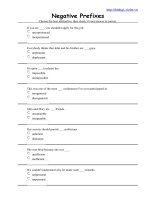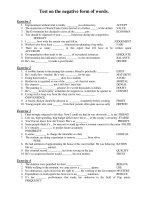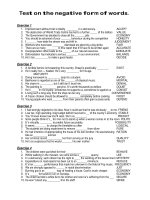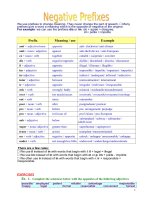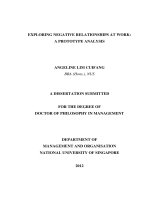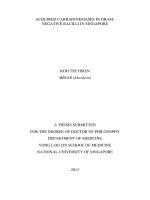Negative indefinites
Bạn đang xem bản rút gọn của tài liệu. Xem và tải ngay bản đầy đủ của tài liệu tại đây (16.11 MB, 282 trang )
Oxrorp
STUDIES
IN THEORETICAL
LINGUISTICS
General editors: David Adger, Queen Mary University of London; Hagit Borer, University of
Southern California
Advisory editors:
Stephen Anderson, Yale University; Daniel Biiring, University of California, Los Angeles;
Nomi Erteschik-Shir, Ben-Gurion University; Donka Farkas, University of California, Santa
Cruz; Angelika Kratzer, University of Massachusetts, Amherst; Andrew Nevins,
University
College London; Christopher Potts, University of Massachusetts, Amherst; Barry Schein,
University of Southern California; Peter Svenonius, University of Troms@; Moira Yip, University College London.
Recent titles
144 Direct Compositionality
edited by Chris Barker and Pauline Jacobson
15 A Natural History of Infixation
by Alan C. L. Yu
16 Phi-Theory
Phi- Features Across Interfaces and Modules
edited by Daniel Harbour, David Adger, and Susana Béjar
17 French Dislocation: Interpretation, Syntax, Acquisition
by Cécile De Cat
18 Inflectional Identity
edited by Asaf Bachrach and Andrew Nevins
19 Lexical Plurals
by Paolo Acquaviva
20 Adjectives and Adverbs
Syntax, Semantics, and Discourse
edited by Louise McNally and Christopher Kennedy
21 InterPhases
Phase-Theoretic lnvestigations of Linguistic Interfaces
edited by Kleanthes Grohmann
22
by
23
by
Negation in Gapping
Sophie Repp
A Derivational Syntax for Information Structure
Luis L6pez
24 Quantification, Definiteness, and Nominalization
edited by Anastasia Giannakidou and Monika Rathert
25 The Syntax of Sentential Stress
by Arsalan Kahnemuyipour
26 Tense, Aspect, and Indexicality
by James Higginbotham
27 Lexical Semantics, Syntax, and Event Structure
edited by Malka Rappaport Hovav, Edit Doron, and Ivy Sichel
28 About the Speaker
Towards a Syntax of Indexicality
by Alessandra Giorgi
29 The Sound Patterns of Syntax
edited by Nomi Erteschik-Shir and Lisa Rochman
30 The Complementizer Phase
edited by E. Phoevos Panagiotidis
31 Interfaces in Linguistics
New Research Perspectives
edited by Raffaella Folli and Christiane Ulbrich
32 Negative Indefinites
by Doris Penka
For a complete list of titles published and in preparation for the series, see pp, 265-6.
Negative Indefinites
DORIS
PENKA
OXFORD
UNIVERSITY
PRESS
OXFORD
UNIVERSITY PRESS
Great Clarendon Street, Oxford ox2 6DP
Oxford University Press is a department of the University of Oxford.
It furthers the University’s objective of excellence in research, scholarship,
and education by publishing worldwide in
Oxford
New York
Auckland Cape Town Dar es Salaam Hong Kong Karachi
Kuala Jampur Madrid Melbourne Mexico City Nairobi
New Delhi Shanghai Taipe: Toronto
With offices in
Argentina
Guatemala
South Korea
Austria
Brazil
Chile
Czech Republic
Hungary Italy Japan Poland
Switzerland
Thailand
Turkey
France
Greece
Portugal Singapore
Ukraine
Vietnam
Oxford is a registered trade mark of Oxford University Press
in the UK and in certain other countries
Published in the United States
by Oxford University Press Inc., New York
© Doris Penka 2011
The moral rights of the author have been asserted
Database right Oxford University Press (maker)
First published 20
Alf rights reserved. No part of this publication may be reproduced,
stored in a retrieval system, or transmitted, in any form or by any means,
without the prior permission in writing of Oxford University Press,
or as expressly permitted by law, or under terms agreed with the appropriate
reprographics rights organization. Enquiries concerning reproduction
outside the scope of the above should be sent to the Rights Department,
Oxford University Press, at the address above
You must not circulate this book in any other binding or cover
and you noust impose the same condition on any acquirer
British Library Cataloguing in Publication Data
Data available
Library of Congress Cataloging in Publication Data
Library of Congress Control Namber: 2010930320
Typeset by SPI Publisher Services, Pondicherry, India
Printed in Great Britain
on acid-free paper by
MPG Books Group, Bodmin and King’s Lynn
978—-0-19-956726-3
(Hbk.)
978—-0~19~956727-0 (Pbk.)
13579108
642
a
ISBN
WL). UBRARIES
|
MAR 25
201
MEGENVED
Contents
Negative indefinites
Sentential negation
1.2.1 Definition of sentential negation
1.2.2 The position of sentential negation
1.3 Outline of the book
1.1
1.2
2. Negative Concord
2.1
~
XI
He
1. Introduction
1X
XI
COW
WH
General Preface
Acknowledgements
List of Abbreviations
The phenomenon of negative concord
2.1.1 First data
14
14
14
2.1.2 Strict and non-strict negative concord
16
Approaches to negative concord
2.2.1 Negative indefinites as negative polarity items
2.2.2 Negative indefinites as negative quantifiers
2.2.3 Negative indefinites as being ambiguous between negative
quantifiers and NPIs
Negative
concord as syntactic agreement
2.3
2.2
2.3.1 The approach of Zeijlstra (2004)
2.3.2 Negative indefinites not associating with sentential
negation
2.3.3 Negative concord in French
2.4 Summary
3. Split Scope of NIs in German
3.1 Data
3.1.1 Modal and other restructuring verbs
3.1.2 Transitive intensional verbs
3.1.3 Predicative uses
3.1.4 Topic—focus accent
3.1.5 Idiomatic expressions
19
20
32
42
47
47
57
76
86
89
89
89
96
98
101
102
vì
Contents
3.1.6 Further data
3.1.7. Conclusion from the data
3.2 Analysis of negative indefinites in German
3.2.1 Scope splitting with respect to verbs
3.2.2 Scope splitting under topic—focus accent
3.2.3 Negative indefinites in sentence-initial position
3.2.4 Negative indefinites inside prepositional phrases
3.3. Comparison with other accounts
3.3.1 Amalgamation and incorporation
3.3.2 Quantification over abstract individuals
3.3.3 Quantification over higher types
3.4 Summary
4. Scope Splitting with Other Downward-Entailing Quantifiers
104
104
106
106
115
125
129
133
133
141
144
150
151
4.1 Background
151
4.2 Only
4.3 Fewer/less than
4.4 Few/little
153
155
162
4.5
At most
167
4.6
Summary
173
5. Distributional Restrictions in Scandinavian
174
5.1 The distribution of negative indefinites in Scandinavian
174
5.2 Analysis of negative indefinites in Scandinavian
5.3 Comparison with other accounts
178
183
5.4 Cross-linguistic perspective on negative indefinites in double
negation languages
6. The Nature of the Licensing Relation
6.1
LF movement of negative indefinites
190
197
197
6.2 Unselective binding
199
6.3
204
Association with operators in a Hamblin semantics
6.4 Distribution of indefinites in negative contexts
7. Tests for the Quantificational Force of Negative Indefinites
212
228
7.1 Background
7.2. Modification by exceptive constructions
228
229
73 Modification by almost
7.3.1 Previous analyses of almost
232
233
7.3.2 Almost as an operator evaluating scalar alternatives
236
Contents
7.3.3 Negative indefinites modified by almost
73-4 Incompatibility of almost and NPIs
7.3.5 Remarks on the syntax of almost
7.4 Summary
vii
239
241
243
244
8. Summary
246
References
Index
249
261
General Preface
The theoretical focus of this series is on the interfaces between subcomponents of the human grammatical system and the closely related area of
the interfaces between the different subdisciplines of linguistics. The notion
of ‘interface’ has become central in grammatical theory (for instance, in
Chomsky’s recent Minimalist Program) and in linguistic practice: work on the
interfaces between syntax and semantics, syntax and morphology, phonology
and phonetics, etc. has led to a deeper understanding of particular linguistic phenomena and of the architecture of the linguistic component of the
mind/brain.
The series covers interfaces between core components of grammar,
including syntax/morphology, syntax/semantics, syntax/phonology, syntax/
pragmatics, morphology/phonology, phonology/phonetics, phonetics/speech
processing, semantics/pragmatics, intonation/discourse structure as well as
issues in the way that the systems of grammar involving these interface
areas are acquired and deployed in use (including language acquisition, language dysfunction, and language processing). It demonstrates, we hope, that
proper understandings of particular linguistic phenomena, languages, language groups, or inter-language variations all require reference to interfaces.
The series is open to work by linguists of all theoretical persuasions and
schools of thought. A main requirement is that authors should write so as to
be understood by colleagues in related subfields of linguistics and by scholars
in cognate disciplines.
In this volume Doris Penka explores the syntactic and semantic conditions on the licensing of negative indefinites. She argues on the basis of a
novel analysis of split scope effects that, in fact, negative indefinites are never
semantically negative; rather they are subject to a syntactic licensing condition
which requires them to be in a dependency with clausal negation, with the way
that this dependency is configured being subject to cross-linguistic variation.
This implies the existence in natural language of phonologically null clausal
negative markers, but allows a maximally simple mapping between the syntax
and the semantics of these items.
David Adger
Hagit Borer
Acknowledgements
This book is a revised version of my doctoral dissertation, which I submitted
to the University of Tubingen in April 2007. I am deeply indebted to the
members of my thesis committee: Arnim von Stechow, Wolfgang Sternefeld,
Sigrid Beck, and Irene Heim. This work would have been impossible without
their guidance, advice, support, and encouragement. I consider myself very
fortunate that these members of my committee were also the people who
taught me semantics and linguistics. Had it not been for them, I would not
be a semanticist or indeed a linguist.
The analysis I present here develops the ideas of Arnim von Stechow that
have been expressed at various points in his work over the last 20 years (see in
particular von Stechow, 1992, 1993; von Stechow and Geuder, 1997). Another
person this work ts particularly indebted to is Hedde Zetjlstra. ] am very happy
J had him as a colleague in a project on negation in Tibingen.
This book has also benefited greatly from detailed and thought-provoking
comments from an anonymous reviewer for Oxford University Press.
I also want to thank the following colleagues for discussion and valuable comments:
Klaus Abels, Fabrizio Arosio, Josef Bayer, Ellen Brandner,
Viviane Déprez, Anamaria
Falaus, Kai von
Fintel, Danny
Fox, Jon Gajewski,
Elena Guerzoni, Jack Hoeksema, Sabine Iatridou, Gianina lordachioaia, Agnes
Jager, Angelika Kratzer, Antje Lahne, Winfried Lechner, Youngjoo Lee, Arne
Martinus Lindstad, Sveta Krasikova, Claudia Maienborn, Luisa Marti,
Cécile Meier, Andrew Nevins, @ystein Nilsen, Rick Nouwen, Orin Percus,
Ingo Reich, Frank Richter, Manfred Sailer, Magdalena Schwager, Jan-Philipp
Sohn,
Uli Sauerland,
Torgrim
Solstad,
and
Hubert
Truckenbrodt.
I have
also received very valuable comments from audiences in Amsterdam, Berlin,
Bilbao, Frankfurt, Oslo, and at MIT.
Thanks also to my friends and colleagues who generously provided native
speaker insights: Anita Bregenzer, Isabelle Darcy, Marcel den Dikken, Chiara
Gianollo, Christl Glauder, Simone Hartung, Anne Kjeldahl, Sveta Krasikova,
Beatriz Lopez Jiménez, Maria Melchiors, Iryna Pur, John Vanderelst, and
Hedde Zeijlstra. I gratefully acknowledge the financial support of the German
Research Council (DFG) to the Sonderforschungsbereich 441 at the University
of Tubingen, where | carried out the research leading to this book. A scholarship from the German Academic Exchange Service (DAAD) enabled me to
spend the spring term of 2003 at MIT. I am also grateful for the support of the
Zukunftskolleg at the University of Konstanz where | am presently a fellow.
List of Abbreviations
Abbreviations used in text:
CP
DE
DegP
DN
DP
FC
{P
LF
NC
NegP
NI
NP
NPI
PF
PP
PPI
QR
TP
VP
complementizer phrase
downward-entailing (monotone decreasing)
degree phrase
double negation
determiner phrase
free choice
inflection phrase
logical form
negative concord
negation phrase
negative indefinite
noun phrase
negative polarity item
phonetic form
preposition phrase
positive polarity item
quantifier raising
tense phrase
verb phrase
Abbreviations used in example glosses:
ACC
COMP
DAT
DET
GEN
CL
INE
INSTR
MOD-PC
NEG
NOM
OBJ-M
PAST
PAST-PART
PERF-PART
accusative case
complementizer
dative case
determiner
genitive case
clitic
infinitive
instrumental case
modal particle
negative marker
nominative case
object marker
past tense
past participle
perfect participle
xii
—- List of Abbreviations
PL
plural
PRES
PRES-PART
present tense
present participle
REEL
reflexive
SG
singular
SUBJ
subjunctive mood
Notation used in examples:
*
xt
...
>
the expression is ungrammatical
the reading is unavailable
the expression is ungrammatical without X
(*X)
‡
#
*?
†?
the expression is ungrammiatical if X is included
marked
highly marked
on the verge of ungrammaticality
judged ungrammatical in the present stage of the language, but
accepted as archaic or formal
accepted by some but not all speakers
infelicitous in the given context
scope over
falling accent
rising accent
~—
Vy
®
*(X)
The thing has gone
nothing.
í love talking about
about.
to
the
nothing,
dogs,
a lot
father.
of damned
It is the
only
nobodies
thing
talking
I know
about
anything
Oscar Wilde, An [deal Husband
Introduction
1.1 Negative indefinites
This book is concerned with the syntax and semantics of negative indefinites.
Following Haspelmath (2005), the term ‘negative indefinite’ 1s used to refer
to the English expressions nobody, nothing, no (as determiner), never and
nowhere, and their counterparts in other languages. The inventory of negative
indefinites (NIs) in some languages is shown in Table 1.1.
The behaviour NIs show with respect to negation is rather diverse, as we
will see in Chapter 2. While in English, German, and Norwegian NIs never cooccur with negation (under an interpretation with one negation), in Italian
and Spanish they sometimes do, and in Polish they always do. This difference
suggests at first glance that the semantic status of NIs in these languages is
rather different. In English, they seem to be inherently negative, while in Polish
they seem to be more like negative polarity items, showing a certain affinity
towards negation. As I will show, these observed. differences are of a rather
superficial nature and a unified analysis of NIs is possible.
For the following investigation, it is useful to have a criterion according to
which elements can be classified as Nls. In particular, it is necessary to have
an effective way of distinguishing NIs from negative polarity items. There is
indeed a unifying characteristic of Nls across languages, which distinguishes
them
from negative polarity items and can be used as a test (see Bernini
TABLE 1.1 Inventory of negative indefinites in a sample of languages
person
thing
time
place
manner
DET
English
German
Norwegian
Italian
Spanish
French
nobody
nothing
never
nowhere
no
niemand —
nichts
nie(mals)
nirgendwo
—
kein
ingen
ingenting
aldri
—
_
ingen
nessuno
niente
mai
—
=
nessuno
nadie — personne
nada
rien
nunca
jamais
~
_
=
—
ninglin
aucun
Polish
nikt
nic
nigdy
nigedzte
nijak
zaden
Negative Indefinites
2
and Ramat, 1996: 121 and Haspelmath, 1997: 194 ff.): Nls contribute negative
meaning in elliptical contexts. In particular, checking whether a given item
can be used as a negative fragmentary answer can be employed as a test. As
illustrated in examples
(1) and (2) (taken from Haspelmath, 1997: 195), the
items that are classified as NIs in Spanish and Polish can be used on their own
as answers. Moreover, when they are, the answer is negative.
(1)
Q:
A:
(2)
Q:
A:
;Qué
viste?
(Spanish)
what see.28G.PAST
‘What did you see?’
Nada.
n-thing
‘Nothing’ (="T didn’t see anything’)
Kto
przysedl
who
came
“Who caine?’
Nikt.
n-person
‘Nobody’ (=“Nobody came’)
(Polish)
In contrast, elements that are classified as negative polarity items, e.g. English
any, cannot be used as negative fragmentary answers.’
(3)
Q:
A:
Who did you meet?
*Anybody.
The term ‘negative indefinite’ is used in a purely descriptive way. It should
not be seen as making a claim about the nature of these expressions. | will in
fact argue that NIs are not semantically negative. Moreover, nothing in the
analysis I will propose hinges on the fact that NIs are indefinites. I regard
this as advantageous for two reasons. First, considering the quickly-changing
analyses of indefinites (e.g. Heim,
1982; Diesing, 1992; Reinhart, 1997; Land-
man, 2004; Kratzer, 2005), 1t is probably safer not to build on any particular
analysis of indefinites. Second, while NIs are the best-studied expressions that
give rise to the phenomena I set out to account for, there are other expressions
that are not indefinites but behave in the same way. One example is the conjunction corresponding to neither...nor. Other elements participating in the
* Jt is crucial that the answer is interpreted as negative. In many languages, indefinites serving as
negative polarity items can also be used as free choice items
(cf. Haspelmath,
1997).
[n the fatter
function, they can be used as fragmentary answers, However, in this case the answer will be positive.
(3)
Q:
A:
What should I write about?
Anything you like. (="You can write about anything you like’)
Introduction
3
same way as NIs in one of the phenomena I will discuss, 1.e. negative concord,
are the focus particles neanche (‘neither’/‘not even’) and nepurre (‘not even’)
in Italian, and ni siquera (‘not even’) and tampoco (‘neither’) in Spanish (see
Herburger, 2001). The claims and analysis I propose should be relevant to these
expressions.
It is an interesting question why indefinites in particular (and other items
similar to indefinites in that their meaning corresponds logically to disjunction) have a special morphological form relating them to negation. In a way,
it is a re-statement of the puzzle as to why there are lexical items expressing negated existential quantification but none expressing negated universal
quantification (see Horn, 2001), [ have nothing to say on this issue.
The standard assumption about the semantics of NIs is that they are negative quantifiers, ic. they denote negated existential quantification (cf. Barwise
and Cooper, 1981, among others), illustrated in (4) by the lexical entry generally assigned to nobody.
(4)
[nobody] =)P.-3x| person(x) & P(x)]
I discuss two phenomena NIs in different languages give rise to that challenge
the analysis of NIs in terms of negative quantifiers. One is negative concord.
There is a rich literature on NIs in languages exhibiting negative concord (see
among others Laka, 1990 and Herburger, 2001, for Spanish; Zanuttini, 1991, for
Italian; Rowlett, 1998, for French; Giannakidou, 1998, for Greek; Brown, 1999,
for Russian; Blaszczak, 2001, for Polish); the phenomenon of negative concord
in general is discussed in Giannakidou
(2006) and Zeijlstra (2004). I take a
more cross-linguistic (albeit European-centred) perspective on NIs and also
include NIs in non-negative concord languages in the discussion. The aim is to
arrive at a cross-linguistically unified analysis of NIs. In non-negative concord
languages, NIs can split their scope in the sense that another operator takes
scope in between the negative and the indefinite meaning component. While
so far negative concord and scope splitting have been discussed independently
of each other, [ bring them together and argue that they reveal the true
nature of NIs. Rather than being negative quantifiers, NIs are semantically
non-negative indefinites that serve as markers of sentential negation. Before
I start setting out the analysis, I will provide some background on sentential
negation.
1.2 Sentential negation
1.2.1 Definition of sentential negation
There ts a traditional distinction between sentential negation and constituent
negation. Klima (1964) introduces four tests to identify sentential negation:
4
Negative Indefinites
the ability to combine with either-conjunctions, the negative appositive tag
not even, positive tag questions, and neither-tags. Each of these tests identifies
the negation contained in the following (a)-sentences as sentential negation,
while ol in the (b)-sentences is classified as constituent negation (examples
from Klima, 1964).
® either-conjoining:
(5)
a. (Publishers will usually reject suggestions.)
Writers will not accept them, either.
*and you did either.
b. He married a not unattractive girl,
.
and you did too.
° the negative appositive tag not even:
(6)
a. The writer will not accept suggestions, not even reasonable ones.
*not even in the desert.
b. There was some rain not long ago,
.
even in the desert.
® positive tag questions:
(7)
a. Writers will never accept suggestions, will they?
b. He had spoken with her not many
P
7
hours earlier.
*had he?
;
° | hadnthe?
° neither-tags:
(8)
a. Writers will never accept suggestions, and neither will publishers.
*and neither
b. He found something interesting there not long ago,
did she.
and so did she.
But Klima’s tests for sentential negation are not without problems. First,
they are specific for English, and not generally applicable to other languages.
Second, they identify not only not and Nis as expressers of sentential negation
but also other expressions like never and seldom, cf. (9), and few.
(9)
(Publishers will usually reject suggestions.)
not
Writers will
never
scarcely
hardly
accept them, either.
seldom
rarely
(10)
a. No rain fell and neither did any snow.
Introduction
5
b. Little rain fell, and neither did much snow.
c. Few writers accept suggestions and neither do many publishers.
That NlIs are classified together with the negative marker not as expressers
of sentential negation is a welcome result. The sentences in (11) intuitively
mean the same, and under standard assumptions they denote identical truth
conditions.
(11)
a. John doesn’t have children.
b. John has no children.
Expressions like seldom, rarely, few, and little, although they share with the
negative marker and Ns the ability to license negative polarity items (NPIs),
are negative in a weaker sense. This weaker notion of negativity, which is sufficient to license NPIs, corresponds to downward entailing (a formal definition
will be given in section 2.2.1.1). It is therefore not negation in the strict sense
to which Klima’s tests are sensitive but rather the weaker notion of downward
entailing.
There is another problematic aspect of Klima’s tests: what they seem to test
for is whether negation takes widest scope. This is illustrated by the following
pair of sentences (from Payne, 1985: 200). Sentence (12a), where negation is
the operator with widest scope, is compatible with Klima’s continuations (or
tags), but (12b), where negation is in the scope of often, 1s not.
(32)
does he?
a. John doesn’t often pay taxes, y and neither did I.
not even to Malta.
does he?
b. ¢2John often doesn’t pay taxes, 4 and neither did I.
not even to Malta.
Thus, applying Klima’s tests, only negation taking widest scope in a clause 1s
classified as sententia] negation. This seems counter-intuitive. If a sentence like
John doesn’t pay taxes involves sentential negation, then a sentence specifying
this further should classify as sentential negation as well.
While these tests classify only negation taking widest scope as sentential
negation, any instance of negation taking widest scope 1s identified as sentential negation. This also holds for negation preceding a preverbal quantifier, as
the following example from Payne (1985: 201) illustrates.
did they?
(13)
Not many students passed, { not even with cribs.
and neither did I.
6
Negative Indefinites
Cases where negation outscopes a preverbal quantifier, as in (13), are often
assumed to involve constituent negation, i.e. negation is regarded a part of
the quantified DP (e.g. Payne, 1985: 202). However, applying the Klima tests
indicates that they express sentential negation, as (13) demonstrates. There are
others reasons to assume that preverbal combinations of a negative marker
and a quantified DP correspond to sentential negation outscoping the DP
rather than constituent negation. First, it can be observed that sentences in the
active voice that involve negation preceding a quantified subject are semantically equivalent to the corresponding sentence in the passive voice with a
negative particle, which is uncontroversally analysed as sentential negation
(see Klima, 1964). For instance, the two sentences in (14) differ regarding the
position of the negative marker but not in their meaning.
(14)
a. Not many people attended the meeting.
b. The meeting wasn’t attended by many people.
The assumption that cases like (14a) involve constituent negation does not
only introduce a distinction that is not supported by intuitions but faces problems too. One problem is that the assumption that the negative marker and the
quantifier form a constituent does not always yield correct truth conditions.
Consider the following example (from Sternefeld, 2006: 333)
(15)
Not every boy can be above average height.
— > can > every
‘It is not possible that every boy is above average height’
In the reading (15) intuitively has, negation takes scope above the modal verb
can, but the quantifier every is interpreted in the scope of the modial, as is
evident in the paraphrase. If the subject is assumed to be the constituent [pp
not every boy], it is not possible to derive truth conditions corresponding to
this reading. It rather has to be assumed that the subject [pp every boy] recon-
structs to its base position below the modal verb, while negation remains in
a higher position. The assumption that preverbal combinations of a negation
and a quantifier involves constituent negation cannot derive adequate truth
conditions for sentences like (15).
Another challenge concerns the distribution of combinations of a negation
and a quantificational DP. If it is assumed that constituent negation forms
one constituent with the quantifier, one would expect that this constituent
can occur in other positions as well. But alleged constituents like [pp not
everyone! or [pp not many people] cannot occur in object position, as (16)
illustrates.
(16)
a. *John saw not many people.
b. *I liked not everyone.
IntroducHon
7
It seems that there is no real distinction between constituent and sentential
negation. Rather, what is at issue is the position of a quantifier interpreted
in the scope of negation: if the quantifier occurs postverbally, negation is
expressed as the negative marker on the finite verb. If the quantifier is in
preverbal position, the negative marker can be placed before it.
The usefulness of the notion ‘constituent negation’ itself has been disputed
(see among others Jacobs, 1982; Dahl, 1993). While in some cases, particularly
instances of lexical negation as in unhappy or independent, it intuitively makes
sense to say that what is negated is a constituent, other cases are less clear.
Consider again some of Klima’s examples classified as constituent negation:
(17)
a. He married a not unattractive girl.
b. There was some rain not long ago.
As pointed out by Dahl (1993), these cases of constituent—or rather non-
sentential—negation can be paraphrased by sentences involving sentential
negation, as in (18), albeit in an embedded clause:
(38)
a. He married a girl who was not unattractive.
b. There was some rain at a time which is located not long ago.
What seems to be at issue is again the scope of negation. In the examples
in (17), the matrix predicate is not in the scope of negation. Thus, negation
qualifies as sentential negation only
if it takes scope above the matrix predicate.
More precisely, and following Acquaviva (1997), sentential negation can be
defined as negation taking scope above the event expressed by the verb. As
proposed by Davidson (1967) sentences can be conceived as descriptions of
events. (The term ‘event’ is used in the loose sense and also includes states.)
The kind of event is determined by the verb. Technically, this means that
verbs have an event argument which is existentially quantified over. In a neo-
Davidsonian approach in the style of Parsons (1990), the sentence (19a), for
example, is represented as (19b), where e is a variable over events:
(19)
a. John kissed Mary.
b, de | aGeNT(John, e) & THEME(Mary. e) & kiss(e) |
According to (19b), the sentence (19a) asserts that there was a kissing event
whose agent was John and whose theme was Mary. If the same sentence 1s
negated, it expresses that no kissing event took place with agent John and
theme Mary.
(20)
a. John didn’t kiss Mary.
b. ¬đ£ [ AsENT(John. £) & rHEME(Mary, e) & kiss(e) |
8
Negative Indefinites
There can be other operators taking scope in between negation and the
event quantifier. This is the case when negation outscopes another scopebearing expression such as a quantifier. Example (21), for instance, means that
not every boy is the agent of a kissing event involving Mary.
(21)
a. Not every boy kissed Mary.
b. =Vx [ boy(x) => đe [ aGENT(x, e) & THEME(Mary, e) & kiss(e) |]
Sentence (21) still constitutes an instance of sentential negation, as the event
quantifier is in the scope of negation, albeit not in the immediate scope of
negation. The definition of sentential negation I will adhere to is the following:
(22) Sentential negation:
Negation taking scope at least above (the existential quantifier binding
the event argument of) the main predicate.
Non-sentential negation, by contrast, does not take scope above the quantifier
binding the event argument of the main predicate. For example, (23a) asserts
the existence of a marrying event, and thus negation does not take scope
above the main predicate marry but only over the predicate unattractive.
Similarly, the negation in (23b) does not negate the existence of a raining event,
but rather that its temporal location counts as long ago.
(23)
a. He married a not unattractive girl.
b. There was some rain not long ago.
A more detailed analysis of some cases involving non-sentential negation will
be given in section 2.3.2.2.
1.2.2 The position of sentential negation
Since Pollock (1989), it is widely assumed that there is a functional projection
in the clausal architecture hosting sentential negation, called NegP. Based on
arguments from English and French, Pollock proposes that the traditional
category IP should be split up into a tense phrase (TP) and an agreement
phrase (AgrP), in between which NegP, the position of the marker of sentential
negation, js located.
(24)
TP
NegP
AgrP
VP
